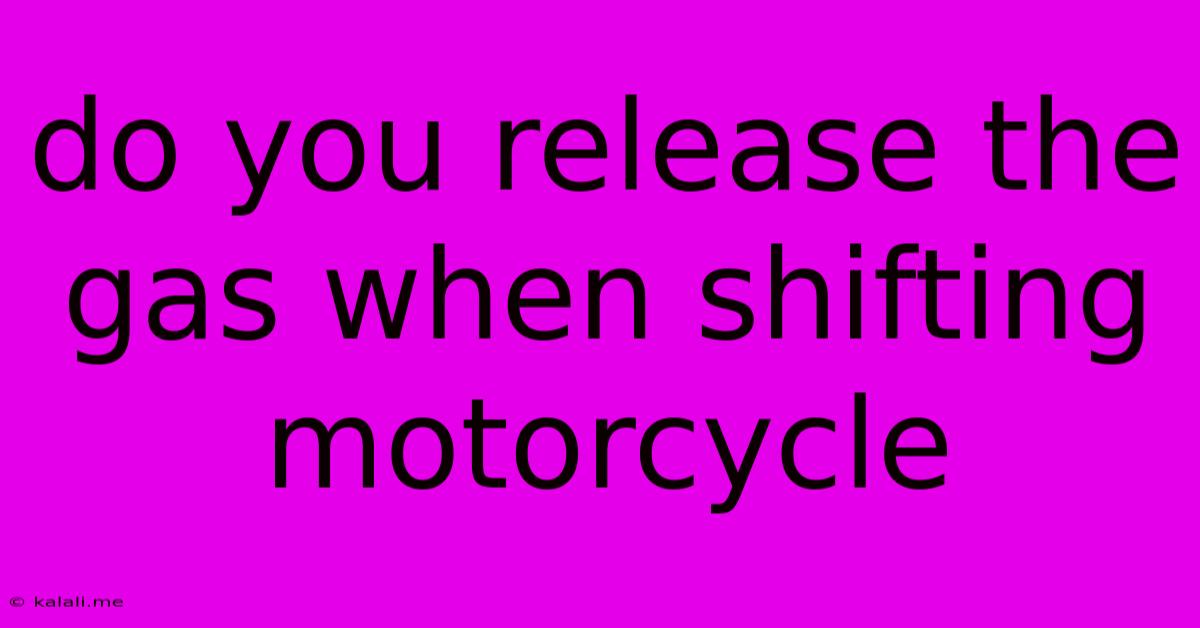Do You Release The Gas When Shifting Motorcycle
Kalali
Jun 06, 2025 · 3 min read

Table of Contents
Do You Release the Gas When Shifting a Motorcycle? A Comprehensive Guide
Meta Description: Learn the proper technique for shifting gears on a motorcycle. Discover whether you should release the throttle, the importance of smooth transitions, and how this impacts performance and safety. This guide covers everything from beginner tips to advanced techniques.
Shifting gears smoothly on a motorcycle is crucial for both performance and safety. While experienced riders might have their own nuances, a fundamental understanding of the process is vital for all motorcyclists. This article will explore the question: do you release the gas when shifting a motorcycle? The answer, while seemingly simple, requires a more nuanced approach.
Understanding the Basics of Motorcycle Shifting
Before diving into the gas release question, let's quickly review the basics of motorcycle shifting. Most motorcycles use a constant-mesh transmission, meaning the gears are always engaged. The shifting mechanism simply selects which gear is actively driving the rear wheel. This contrasts with car transmissions, which require complete disengagement of the clutch before gear changes.
The process typically involves:
- Clutch Lever: Pulling in the clutch lever disengages the engine from the transmission.
- Gear Shift Lever: Moving the gear shift lever up or down selects the desired gear.
- Throttle: Controlling engine speed with the throttle.
- Clutch Release: Slowly releasing the clutch lever re-engages the engine and transmission.
Should You Release the Throttle When Shifting?
The short answer is: it depends. There isn't a universally applicable "yes" or "no." The optimal technique blends several factors:
- Smoothness: The primary goal is a smooth shift. Abrupt shifts, especially under acceleration, can disrupt traction, causing instability, particularly at lower speeds.
- Engine RPM: High engine RPMs generally require a slightly more pronounced throttle roll-off for seamless gear changes. Lower RPMs often allow for shifts with minimal throttle adjustment.
- Riding Style: Aggressive riding styles often necessitate a slightly different approach than leisurely cruising.
- Motorcycle Type: Different motorcycles may respond slightly differently to shifting techniques.
The Recommended Approach: A Balanced Technique
For most situations, a balanced technique is best. This involves a gentle roll-off of the throttle just before operating the clutch. This prevents sudden engine braking and allows for a smoother transition between gears. This is particularly important when upshifting. Downshifting requires more careful consideration to match engine speed to road speed, often requiring a bit more throttle control to avoid engine lugging or a sudden increase in speed.
Think of it like this: You're not completely shutting off the gas, but you're momentarily reducing the amount of power being delivered to the rear wheel. This helps to synchronize engine speed with the gear change.
Advanced Techniques and Specific Scenarios
Experienced riders may employ more advanced techniques depending on the riding situation:
- Clutchless Shifting: While not recommended for beginners, experienced riders might use clutchless shifting in certain situations, requiring precise throttle control.
- Downshifting for Engine Braking: Downshifting can provide engine braking, slowing the motorcycle down, and may require less throttle reduction as the engine speed is brought back up to match the selected gear.
Practice Makes Perfect
Mastering the art of motorcycle shifting takes practice. Start in a safe, open area and experiment with different techniques. Pay close attention to the feel of the motorcycle and gradually refine your approach to find what feels most comfortable and effective for you. Always prioritize smooth transitions to maintain control and safety.
By understanding the factors influencing shifting techniques, you can improve your riding skills, enhance your motorcycle's performance, and, most importantly, ride safer. Remember, smooth shifts are key to a pleasurable and controlled ride.
Latest Posts
Latest Posts
-
How Long It Took Noah To Build The Ark
Jun 07, 2025
-
How To Tie Fishing Hook To Line
Jun 07, 2025
-
How To Calculate That A Bolt Wont Come Lose
Jun 07, 2025
-
Does Double Booking Need A Hyphen
Jun 07, 2025
-
How Do I Use A French Press
Jun 07, 2025
Related Post
Thank you for visiting our website which covers about Do You Release The Gas When Shifting Motorcycle . We hope the information provided has been useful to you. Feel free to contact us if you have any questions or need further assistance. See you next time and don't miss to bookmark.